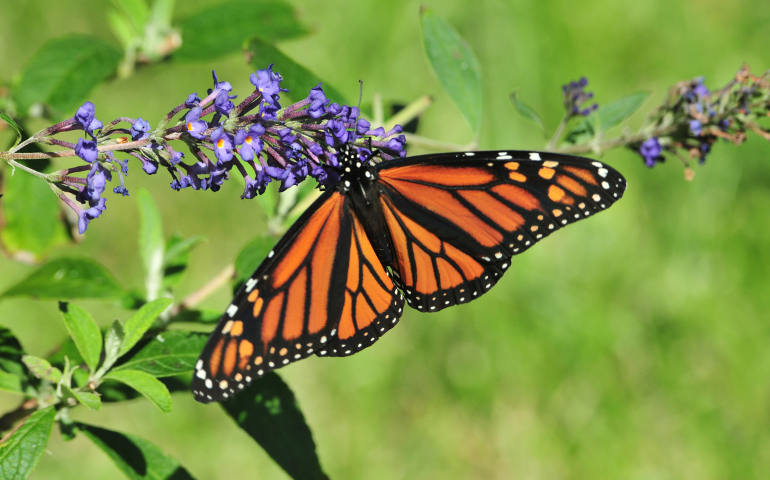
A monarch butterfly feeds on a butterfly bush Oct. 6, 2011 on Maryland's Eastern Shore near Cambridge in preparation for its autumn migration to Mexico. (CNS photo/Thomas Lorsung)
On Easter Sunday, we will celebrate Jesus’ transformation into cosmic aliveness. His is the ultimate miraculous escape from that dreaded, dark and rocky tomb with the one-way door, a no-escape final resting place for the dead.
Jesus’ resurrection was perfect for restoring hope and joy to family, friends and followers. He completely rattled and confounded the tyrannical political leaders who used every kind of cruelty to keep their subjects in line on a daily basis.
Jesus’ teachings were all about replacing their tyrannical tactics with life-affirming acts of gentleness, love, social justice and the nurturing and healing of all beings.
Generation by generation, we struggle to make his message work. In the process we often toggle back and forth between our own personal Good Friday and Easter Sunday moments.
Sometimes I sink into a “when will things really change? I want them to happen right now” funk. The latest bout occurred after an Oakland friend emailed me a YouTube video of Michael Jackson’s 1995 “Earth Song.” It features shots of burning forests, grieving and displaced people, and elephants slaughtered for their ivory tusks.
Spoiler alert: If you hate to weep, do not view; it will shred the very depths of your soul. The last moments of the film spin backwards to their original blessed scenes of a healed earth. Some of my sorrow in viewing the video came from realizing that 20 years have passed and the problems continue, despite efforts at the political and environmental levels.
The Amazon rainforest still poses great danger for social activists, like Sr. Dorothy Stang, working on the behalf of small-scale farmers. A story last week from EcoWatch.com told of the poaching trade that has become a $20 billion business and killed more than 100,000 elephants since 2010 – what the writers deemed “a global war against nature.”
Appalling scenarios, right? They call to mind how the Earth suffers from its own version Good Friday crucifixions everywhere.
All the sadness and sense of grief at times make it difficult to stay balanced and to remember the thousands of positive efforts also taking place -- those kinds of “Easter Sunday” ecological resurrections. But there I was that day, stuck in Good Friday mode.
Stuck in Good Friday mode from the video, the name Trina Paulus popped into my head. How would the Catholic writer, sculptor and member of the Intentional Grail Movement view these developments?
I recalled she had written a visionary book for people like myself, Hope for the Flowers. The book’s cover tells us this is “a tale -- partly about life, partly about revolution and lots about hope for adults and others (including caterpillars who can read).”
Written and illustrated by Paulus 43 years ago, Hope, now available as an e-book, tells the tale of little caterpillars Stripe and Yellow. The two attempt to climb a pillar of fellow caterpillars stretching to the sky -- where the only way up is by crowding, pushing and squashing each other in pursuit of the peak -- only to later decide to return to the ground. Eventually, both spin cocoons and reach the sky as butterflies. They have joined the earth with heaven, “carrying the seeds of love from one flower to another.”
Through her timeless allegory, Paulus encourages each of us to jump off our personal pillars -- of despair, inertia, fear, complacency, upward financial mobility, security or whatever keeps us human caterpillars enmeshed -- and to spin ourselves into cocoons and to emerge as carriers of hope and service. There is room for us butterflies everywhere.
During a phone interview, the 83-year-old Montclair, N.J., resident reflected on a “constellations of three factors” that gave birth to her book.
“The image of a caterpillar that so mysteriously contains a glorious winged butterfly always showed for me as a symbol making it possible to believe in resurrection,” she told NCR. “It is so hard to believe when you see a caterpillar or human being that such a thing can happen.”
Paulus said she used to make cards with those images and the words “Life is changed, not taken away” -- from the preface to the Mass for the Dead to comfort people when a loved one passes away.
A second influence emerged from her time in Egypt in 1966 while working with young girls so poor they could not go to school.
“The drastic inequalities that plague the earth then were grim but my culture shock was greatest when I returned home,” Paulus said. “This needed changing, and along with the revolutionary push in the late 1960s made me ask this still relevant question about what is the real revolution that will not just change things superficially? Hope for the Flowers is an attempt toward an answer.”
Her third reason: She had a contract with Paulist Press to send them the final manuscript. The book received the 1972 Christopher Award as the most inspiring read.
Paulus has been busy in the years since Hope’s publishing. She has protested against toxic storage waste sites, became involved in permaculture, and is active in the battle against genetically modified organisms. She currently serves as vice president of both the Cornucopia Network of NJ and the Central Rocky Mountain Permaculture Institute.
She also raises several hundred Monarch butterflies each summer in her house, where they enjoy a much higher survival rate than the single-digit forecasts in the wild. Each fall, she waves them off on their long journey to Mexico where they will spend their winter before flying north in the spring.
For fans of Yellow and Stripe, a welcome surprise awaits: Their creator has two sequels in the works. Their next adventure will take them into the desert to help thirsty butterflies get water so they and the flowers can flourish.
As for the current environmental situation, Paulus offered some parting words: “Things are not yet lost. And remember, Jesus would never give up.”
Indeed, a young green movement has grown in China, Australia is opening a massive marine preserve off its coasts, and New York has banned fracking.
Such events certainly point to the shrinking of Paulus’ caterpillar pillar. More and more people are leaving behind the craziness driving the pile to work for social and environmental good.
Such a gift of hope to receive for Easter Sunday -- to be reminded that we are the lifeline of butterflies the Earth needs now.
Editor's note: Want more stories from Eco Catholic? We can send you an email alert once a week with the latest. Just go to this page and follow directions: Email alert sign-up.




